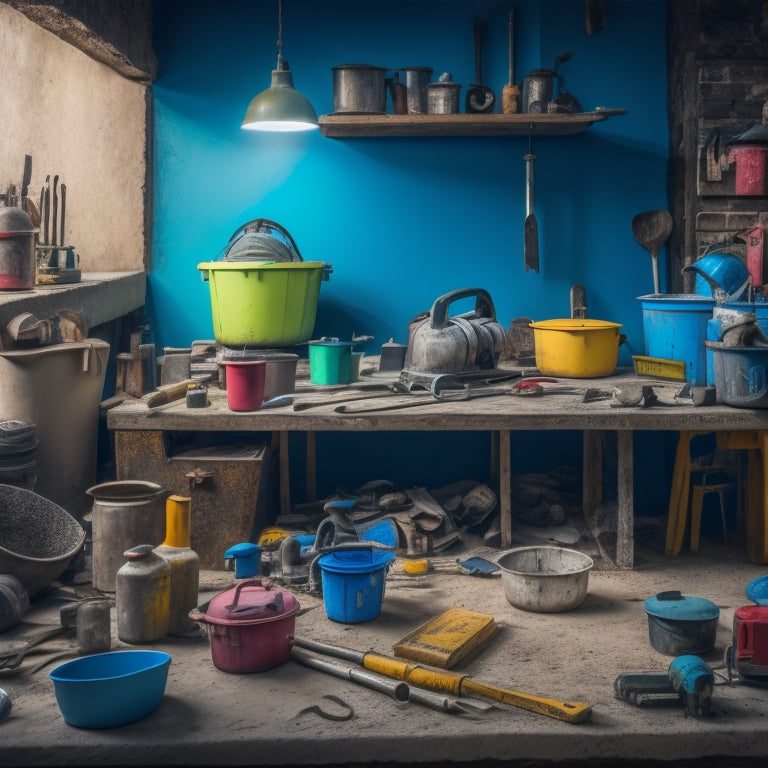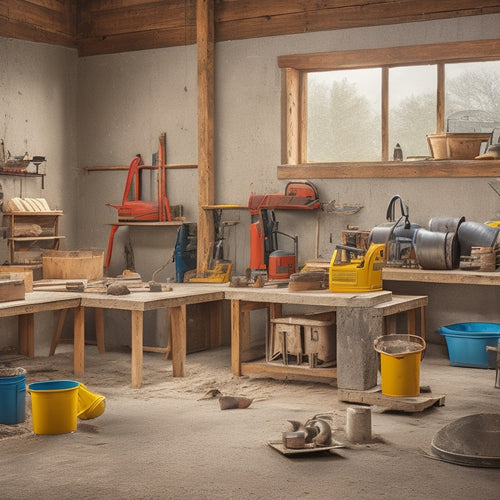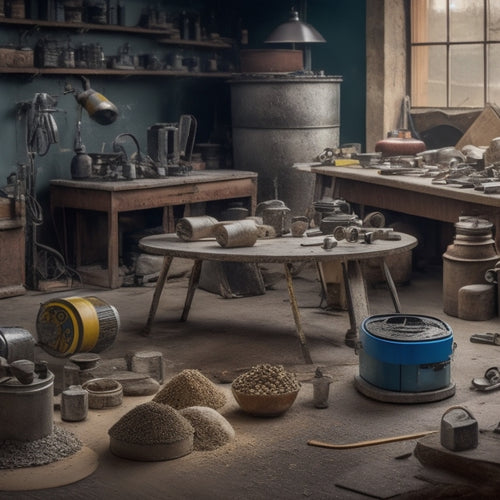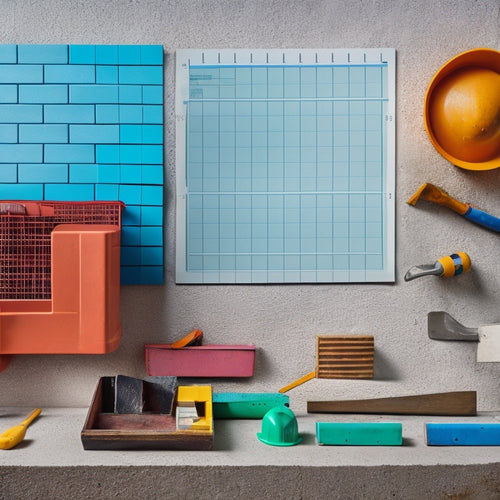
7 Must-Know Tips for Buying Concrete Home Tools
Share
When buying concrete home tools, you're not just purchasing equipment, you're investing in the quality of your project's outcome, making it essential to get it right from the start. To guarantee a successful project, start by establishing a realistic budget that includes equipment, materials, and upgrades. Next, select the right trowel type and float for your specific project needs, considering factors like durability, size, and material. Don't overlook the importance of handle material, ergonomics, weight, and balance, as well as blade quality. Finally, evaluate the warranty and customer support offered by the supplier. By following these must-know tips, you'll be well on your way to achieving a flawless finish - and uncovering the full potential of your project.
Key Takeaways
• Establish a realistic budget that includes equipment, materials, and upgrades to ensure comprehensive planning.
• Choose trowels and floats based on material durability, size, and blade shape to match specific project requirements.
• Prioritize ergonomic handle designs with durable materials, contoured grips, and cushioning features for comfort and precise control.
• Assess weight distribution and balance points to reduce fatigue and strain during extended tool use.
• Evaluate warranty length, scope, and customer support availability to ensure investment protection and timely issue resolution.
Set a Realistic Budget Plan
To guarantee a successful concrete home tool purchase, you must set a realistic budget plan that accounts for the costs of necessary equipment, materials, and potential upgrades. This is essential because it will help you navigate budget constraints and make informed decisions.
Start by researching the market to get an idea of the costs involved. Compare prices from different suppliers to identify the best deals. Consider the quality of the tools and materials you need, as well as their durability and performance.
A cost comparison will help you separate must-haves from nice-to-haves, making sure you allocate your budget wisely. Be prepared to make adjustments as needed, and don't hesitate to seek advice from experts if you're unsure.
Choose the Right Trowel Type
You'll need a trowel that's specifically designed for concrete work, as it will help you achieve a smooth, even finish. When selecting a trowel, consider the material. Stainless steel and high-carbon steel trowels are durable and resistant to rust, making them ideal for concrete work.
You'll also need to choose the right size trowel for your project. Trowel sizes range from 12 to 24 inches, with smaller sizes suitable for detail work and larger sizes for covering larger areas.
Consider the type of concrete you're working with, as well. If you're working with thick, heavy concrete, you'll need a trowel with a sturdy handle and a robust blade. For thinner, more delicate concrete, a lighter trowel with a more flexible blade may be more suitable.
Additionally, think about the type of finish you're aiming for. A trowel with a curved or angled blade can help you achieve a more textured or decorative finish, while a flat blade is better suited for a smooth, flat finish.
Ultimately, the right trowel will depend on your specific project needs and preferences. By choosing the right trowel material, size, and type, you'll be well on your way to achieving professional-looking results.
Float Selection for Smooth Finish
With your trowel selected, it's time to turn your attention to the float, a tool that will help you achieve a smooth, even finish by knocking down ridges and humps in the freshly poured concrete.
When choosing a float, you'll need to contemplate the type and material that best suits your project's requirements. There are two primary float types: bull floats and darby floats. Bull floats are larger, ranging from 24 to 48 inches, and are ideal for large, open areas. Darby floats, on the other hand, are smaller, typically 4 to 8 inches, and are better suited for smaller areas, edges, and corners.
Float materials also vary, with options including magnesium, aluminum, and resin. Magnesium floats are durable and resistant to rust, making them a popular choice. Aluminum floats are lightweight and easy to maneuver, while resin floats offer a cost-effective option.
You may also contemplate the float's edge type, with options including rounded, square, or notched. Ultimately, the right float will depend on your specific project needs, so take the time to research and choose the one that will help you achieve a flawless finish.
Handle Material and Ergonomics Matter
Selecting the right handle material and ergonomic design for your float is essential, as it directly impacts your comfort, control, and overall performance during the finishing process.
You'll want to choose a handle that provides a secure grip, reduces fatigue, and allows for precise maneuverability.
Here are three key considerations to keep in mind:
-
Material durability: Look for handles made from high-quality, durable materials that can withstand the rigors of concrete finishing. Fiberglass, wood, and steel are popular options, each with their own strengths and weaknesses.
-
Ergonomic design: A well-designed handle should fit comfortably in your hand, allowing you to maintain a secure grip even when working with heavy or large floats. Consider handles with contoured grips, cushioning, or textured surfaces to reduce slippage.
-
Handle design: The shape and length of the handle can also impact your performance. Look for handles with a balanced design that allows for easy maneuverability and control.
Check the Weight and Balance
When checking the weight and balance of your concrete home tool, you'll want to contemplate how the weight is distributed.
A well-balanced tool will reduce fatigue and improve your overall handling comfort level.
You should look for tools that combine ideal weight distribution with ergonomic design to guarantee a comfortable grip and effortless maneuverability.
Tool Weight Distribution
You need to guarantee the tool's weight is evenly distributed and balanced to prevent fatigue and maintain control during extended use. Uneven weight distribution can lead to poor tool stability, which negatively impacts your work quality and puts you at risk of injury.
When evaluating a tool, consider the following key aspects of weight distribution:
-
Center of gravity: Verify the tool's center of gravity is close to the grip or handle, allowing for ideal load management and reduced strain on your body.
-
Weight concentration: Check if the tool's weight is concentrated in a specific area, affecting its overall balance and stability.
-
Counterbalancing: Look for tools with built-in counterbalancing features, such as offsetting weights or clever design elements, that help maintain a balanced feel.
Balance and Ergonomics
By ensuring proper weight distribution, you're better positioned to focus on the tool's balance and ergonomics, which play an important role in reducing fatigue and discomfort during extended use.
A well-balanced tool allows you to maintain control and precision, even in demanding tasks. Look for tools with ergonomic design that fit comfortably in your hand, reducing strain on your wrists and arms.
Grip technology is also vital, as it provides a secure hold, even in wet or slippery conditions. A good grip should be contoured to fit your hand, with textured surfaces to prevent slipping.
Additionally, consider the tool's center of gravity, ensuring it's centered and evenly distributed. This will reduce the likelihood of the tool twisting or tilting during use, making it easier to maneuver.
Handling Comfort Level
To guarantee a comfortable handling experience, the weight and balance of a concrete home tool must be carefully assessed, as an improperly weighted tool can quickly lead to fatigue and discomfort.
When selecting a tool, evaluate how it fits in your hand, paying attention to the distribution of weight and the balance point. A well-balanced tool will reduce strain on your muscles, allowing you to work for extended periods without fatigue.
Here are three key factors to evaluate when assessing the weight and balance of a concrete home tool:
-
Grip feel: Hold the tool in your dominant hand, paying attention to how the grip feels. Is it comfortable? Does it fit snugly?
-
Balance point: Hold the tool at different angles, noting how the weight shifts. A well-balanced tool will feel steady and controlled.
-
Weight distribution: Lift the tool, paying attention to how the weight is distributed. A tool that's too heavy or too light can lead to fatigue and discomfort.
Inspect the Blade Quality Closely
Concrete saw blades undergo rigorous manufacturing processes, but inspecting their quality closely can still reveal subtle differences that impact performance.
When you're buying a concrete saw, you'll want to examine the blade's quality to verify it can deliver peak cutting efficiency. Look for blades with a high-quality diamond coating, as this will reduce wear and tear, making blade maintenance easier. A well-coated blade will also help you achieve a smoother cut, reducing the risk of kickback.
You should also inspect the blade's core material, checking for durability and resistance to heat buildup. A high-quality core will help prevent warping or damage during extended use.
Additionally, examine the blade's arbor hole, confirming it's precision-drilled to fit your saw's arbor perfectly. A well-maintained blade won't only extend its lifespan but also improve overall cutting efficiency.
Warranty and Customer Support
When purchasing concrete home tools, you'll want to carefully evaluate the warranty and customer support offered by the manufacturer.
You should consider the length of the coverage period, as well as the availability of the support team in case you encounter any issues.
Additionally, make certain you understand the return policy, including any stipulations or requirements, to guarantee you're protected in case you're not satisfied with your purchase.
Coverage Period Matters
You'll want to scrutinize the warranty and customer support offered by manufacturers, as an extensive coverage period can be a deciding factor in your purchase decision. A longer coverage duration directly impacts tool longevity, giving you peace of mind and protecting your investment.
Here are three key aspects to evaluate:
-
Length of coverage: Look for manufacturers offering warranties that extend beyond the standard 1-year mark. A 3- to 5-year warranty can provide added security and reduce maintenance costs.
-
Coverage scope: Check what's included in the warranty. Does it cover parts, labor, or both? Are there any exclusions or limitations?
-
Claims process: Understand the process for filing claims and receiving support. Is it straightforward, or will you be left waiting for weeks or months for a resolution?
Support Team Availability
Most manufacturers provide a dedicated support team to back their warranty and customer support claims, and it's essential to assess their availability and responsiveness to guarantee timely issue resolution. When evaluating support team availability, you should consider factors like operating hours, response times, and communication channels. You want to make sure that you can quickly get in touch with the support team in case you encounter any issues with your concrete home tools.
| Support Channel | Response Time | Operating Hours |
| Phone Support | 1 hour | 24/7 |
| Email Support | 4 hours | Mon-Fri, 9am-5pm |
| Live Chat | Instant | Mon-Sat, 10am-6pm |
Return Policy Clarity
The return policy clarity of a manufacturer's warranty and customer support is crucial, as it directly affects your ability to quickly and easily resolve issues with your concrete home tools. When evaluating a manufacturer's return policy, you want to ascertain that it's clear, concise, and easy to understand. This will save you time and frustration in the event you need to return or exchange a tool.
Here are three key aspects to reflect on:
-
Return window: How long do you have to return a tool if it doesn't meet your expectations?
-
Exchange process: What's the process for exchanging a defective tool for a new one, and how long will it take?
-
Restocking fees: Are there any fees associated with returning a tool, and if so, how much will you be charged?
Frequently Asked Questions
Can I Use a Concrete Tool for Both Mixing and Finishing?
Can you use a concrete tool for both mixing and finishing? Technically, yes, but it's not recommended.
You risk compromising the quality of your project by using the same tool for both tasks. Mixing techniques require a tool that can handle aggressive blending, while finishing methods demand a more precise, gentle touch.
Using one tool for both can lead to inconsistent results and a lower-quality finish.
Will a Heavier Tool Provide More Leverage and Power?
Did you know that the average concrete mixer can handle up to 400 pounds of material per batch?
When it comes to your tool, you're right to wonder if a heavier tool means more leverage and power.
The truth is, a heavier tool doesn't always translate to more power.
What matters is the power dynamics between the tool's weight, motor strength, and gear ratio.
You'll get more power from a well-balanced tool that distributes its weight efficiently, not just a heavy one.
Are Concrete Tools Suitable for Working With Other Materials?
When considering concrete tools, you'll likely wonder if they're suitable for working with other materials.
The good news is that many concrete tools offer versatility and material compatibility. You'll find that tamping tools, for instance, can be used for compacting soil or gravel, while finishing tools like trowels can be used for smoothing out plaster or stucco.
However, it's important to check the manufacturer's recommendations to verify the tool is designed for the specific material you're working with.
Do I Need to Clean and Maintain My Concrete Tools Regularly?
As you wield your concrete tools, think of them as precision instruments, not rugged brutes.
To keep them finely tuned, you'll need to clean and maintain them regularly. Develop a maintenance schedule to make certain your tools stay in top shape.
Mastering cleaning techniques, such as wire-brushing and solvent-wiping, will prevent rust and corrosion.
Can I Repair or Sharpen a Damaged Concrete Tool Blade?
You're wondering if you can repair or sharpen a damaged concrete tool blade. The answer is yes, with the right techniques.
Blade restoration is a skill that requires patience and practice. You'll need to master sharpening techniques, such as using a diamond stone or a bench grinder, to restore your blade's edge.
Conclusion
By following these 7 must-know tips, you'll be well-equipped to select the right concrete home tools for your project.
For instance, consider a contractor who invested in a high-quality trowel with an ergonomic handle, resulting in a 30% reduction in fatigue and a 25% increase in productivity.
With the right tools, you can achieve professional-grade results and take your concrete work to the next level.
Related Posts
-

What Tools to Rent for a Concrete Home Reno
When tackling a concrete home renovation, you'll need to rent a variety of specialized tools to get the job done. For...
-

Top DIY Concrete Grinding and Polishing Tools
When selecting DIY concrete grinding and polishing tools, you'll want to take into account a range of factors to guar...
-

Reinforcement Tools Checklist for Concrete Block Walls
You'll need a range of reinforcement materials, including horizontal and vertical rebar, fiber mesh, and anchor bolts...


